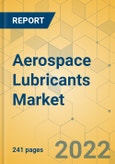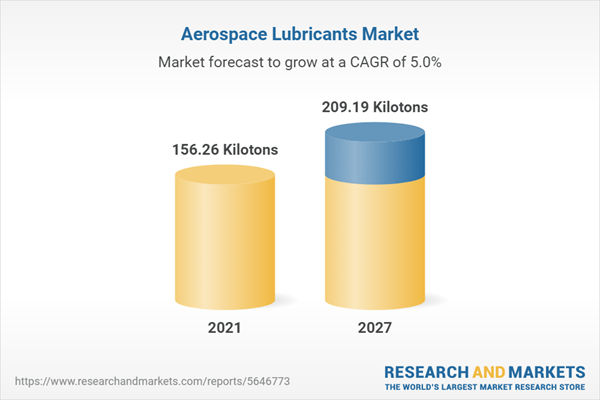Speak directly to the analyst to clarify any post sales queries you may have.
MARKET DRIVERS: Growing Demand for Air Travel
The aviation and aerospace industry is driven by air travel; in recent years, the number of people traveling by air has increased significantly. Additionally, the demand for air transportation has increased because it offers the fast mobility essential for perishable goods. Rapid industrialization has increased the spending capacity of people, and automation has enabled quick mobility for people and commodities. Air transport helps people travel globally, remarkably impacting economic and social development. Air transport provides a vast network of transportation with fast mobility, which is essential for trade, business, and tourism industries that promote economic growth. According to International Civil Aviation Organization (ICAO), in 2019, 4.5 billion people traveled by air transport, and 57.6 million tons of freight has been carried by air. Additionally, according to International Air Transport Association (IATA), airlines worldwide have been transporting more than 52 million tons of commodities per year, representing more than 35% of total goods transported across the world and, in monetary terms, amounts to $6.8 trillion worth of goods.MARKET OPPORTUNITIES: Stringent Environmental Regulation Boosting Demand for Eco-Friendly Lubricants
Various government entities, such as Environment Protection Agency (EPA) and International Civil Aviation Organisation (ICAO), have laid down emission norms for engines and turbines of aircraft. These regulations will reduce airplanes' fuel consumption and offer better aircraft performance for aircraft. Therefore, stringent emission regulations have increased the demand for eco-friendly aerospace lubricants. Furthermore, there is a high investment in R&D for the aerospace sector to develop aircraft which will fly efficiently on alternative energies such as hydrogen and electricity. Moreover, the defense sector of various countries has taken a sustainable approach to the aviation industry, which increased the demand for aircraft with minimal environmental impact. Additionally, engine and turbine design advancements to reduce greenhouse gas emissions, leading to low environmental impact, will increase the demand.CHALLENGES: Contamination of Lubricants
Contamination of aerospace lubricants can have some adverse effects on aircraft operations. Contamination of oils may change the physical and chemical properties of the fat. The change in properties of lubricants may affect the performance of aircraft. Additionally, the contaminated lubricants may lead to speedy wear and tear of planes' mechanical parts, which can cause accidents.Aerospace lubricants comprise base oils and a few chemical additives specially formulated to protect the lubricating properties of oil and components used in aircraft. Additives are specialty chemicals customized to boost performance. Generally, additives used in aviation lubricants are dispersants, antioxidants, detergents, anti-corrosion, anti-foaming agents, and viscosity retainers. Under extreme temperature condition, the degradation process of additives speed up and can trigger other chemical reactions. This chemical reaction may produce some chemical contaminants that may affect aircraft performance.
MARKET SEGMENTS
Aftermarket is expected to be the largest segment in the global aviation lubricants market.Aerospace lubricants are essential for an aircraft's healthy functioning regarding passengers' safety and performance. It plays a vital role in aircraft performance, protecting against wear and tear of moving parts in the turbine, piston engine, and hydraulic systems. Aerospace lubricants consist of base oils and various additives, giving a broad spectrum of properties. Aftermarket is the most significant end-user segment as the price of an aircraft is very high; thus, the purchase rate is very low. Therefore, the maintenance of aircraft is essential for civil and defense aviation. Lubricants are consumed in an aircraft due to extreme conditions such as high temperature and high pressure. Therefore, there is a need for frequent changes of lubricants to maintain the aircraft.
End-User
- OEM
- Aftermarket
Application
- Defence Aviation
- Civil Aviation
Engine oil is generally available in two types which are piston engine oil and turbine engine oil. These two engine oil types are specially designed per the engine used in the aircraft. Aerospace lubricants are essential to any aircraft as almost every aircraft requires some lubricant. Engine oil is one of the most commonly used lubricants in the market, as most aircraft need engine oil to reduce the wear and tear of the engine and turbine. The hydraulic fluids are required to operate various mechanical functions of aircraft that require high force, which reduces the pilot's efforts. Hydraulic power is used for aircraft parts such as nose wheel steering, spoilers, speed brakes, landing gear retraction/extension, wheel brakes, flaps and slats, thrust reversers, flight control surfaces, cargo doors, loading ramps, and windshield wipers.
Products:
- Engine Oil
- Hydraulic Oil
- Others
Geography
- North America
- US
- Canada
- Europe
- Germany
- UK
- France
- Russia
- Italy
- APAC
- China
- India
- Japan
- South Korea
- Indonesia
- Rest of APAC
- Latin America
- Brazil
- Mexico
- Rest of Latin America
- Middle East & Africa
- South Africa
- UAE
MAJOR COMPANY AND STRATEGIES
The key players have undertaken various strategies to grow in the aerospace lubricants market. Companies in the aerospace lubricant industry compete strategically. The growth in sustainable processes and initiatives has challenged all companies globally. Investments in R&D, technological advancement, and environmental and economic challenges drive the demand for innovative and sustainable aerospace lubricant products.Prominent Vendors
- ExxonMobil
- Shell
- Total Energies
- Nyco
- Phillips66 (US)
Other Prominent Vendors
- Aerospace
- AVI Oil India
- Castrol
- Chemours
- Eastman Chemicals
- Jet Lube
- NYE Lubricants
- Perstorp Group
- PetrelPus Inc
- Radco Industries
- Rocol
- Sinopec
- The Warefield
KEY QUESTIONS ANSWERED
1. What is the total market value of the aviation lubricants market?2. What are the key driving factors for the growth of the aerospace lubricants market?
3. What are key sustainability strategies adopted by leading players operating in the aviation lubricants market?
4. Who are the leading vendors in the global aviation lubricants market?
Table of Contents
Companies Mentioned
- ExxonMobil
- Shell
- Total Energies
- Nyco
- Phillips66 (US)
- Aerospace
- AVI Oil India
- Castrol
- Chemours
- Eastman Chemicals
- Jet Lube
- NYE Lubricants
- Perstorp Group
- PetrelPus Inc
- Radco Industries
- Rocol
- Sinopec
- The Warefield
Methodology
Our research comprises a mix of primary and secondary research. The secondary research sources that are typically referred to include, but are not limited to, company websites, annual reports, financial reports, company pipeline charts, broker reports, investor presentations and SEC filings, journals and conferences, internal proprietary databases, news articles, press releases, and webcasts specific to the companies operating in any given market.
Primary research involves email interactions with the industry participants across major geographies. The participants who typically take part in such a process include, but are not limited to, CEOs, VPs, business development managers, market intelligence managers, and national sales managers. We primarily rely on internal research work and internal databases that we have populated over the years. We cross-verify our secondary research findings with the primary respondents participating in the study.

LOADING...
Table Information
| Report Attribute | Details |
|---|---|
| No. of Pages | 241 |
| Published | August 2022 |
| Forecast Period | 2021 - 2027 |
| Estimated Market Value in 2021 | 156.26 Kilotons |
| Forecasted Market Value by 2027 | 209.19 Kilotons |
| Compound Annual Growth Rate | 4.9% |
| Regions Covered | Global |
| No. of Companies Mentioned | 18 |









